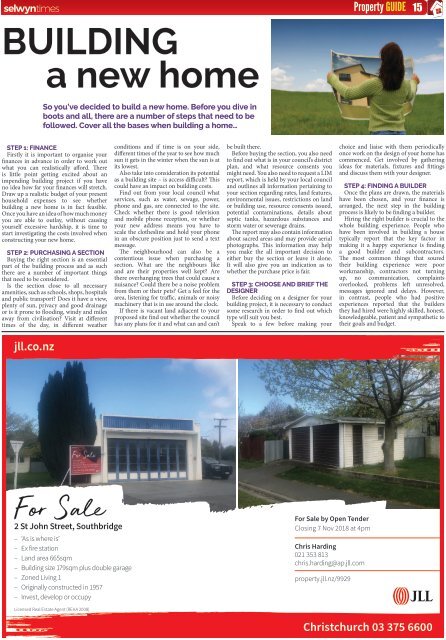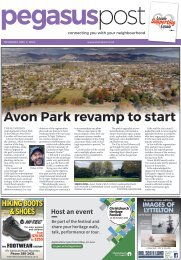You also want an ePaper? Increase the reach of your titles
YUMPU automatically turns print PDFs into web optimized ePapers that Google loves.
2<br />
[Edition datE]<br />
15<br />
BUILDING<br />
a new home<br />
So you’ve decided to build a new home. Before you dive in<br />
boots and all, there are a number of steps that need to be<br />
followed. Cover all the bases when building a home…<br />
STEP 1: FINANCE<br />
Firstly it is important to organise your<br />
finances in advance in order to work out<br />
what you can realistically afford. There<br />
is little point getting excited about an<br />
impending building project if you have<br />
no idea how far your finances will stretch.<br />
Draw up a realistic budget of your present<br />
household expenses to see whether<br />
building a new home is in fact feasible.<br />
Once you have an idea of how much money<br />
you are able to outlay, without causing<br />
yourself excessive hardship, it is time to<br />
start investigating the costs involved when<br />
constructing your new home.<br />
STEP 2: PURCHASING A SECTION<br />
Buying the right section is an essential<br />
part of the building process and as such<br />
there are a number of important things<br />
that need to be considered.<br />
Is the section close to all necessary<br />
amenities, such as schools, shops, hospitals<br />
and public transport? Does it have a view,<br />
plenty of sun, privacy and good drainage<br />
or is it prone to flooding, windy and miles<br />
away from civilisation? Visit at different<br />
times of the day, in different weather<br />
conditions and if time is on your side,<br />
different times of the year to see how much<br />
sun it gets in the winter when the sun is at<br />
its lowest.<br />
Also take into consideration its potential<br />
as a building site – is access difficult? This<br />
could have an impact on building costs.<br />
Find out from your local council what<br />
services, such as water, sewage, power,<br />
phone and gas, are connected to the site.<br />
Check whether there is good television<br />
and mobile phone reception, or whether<br />
your new address means you have to<br />
scale the clothesline and hold your phone<br />
in an obscure position just to send a text<br />
message.<br />
The neighbourhood can also be a<br />
contentious issue when purchasing a<br />
section. What are the neighbours like<br />
and are their properties well kept? Are<br />
there overhanging trees that could cause a<br />
nuisance? Could there be a noise problem<br />
from them or their pets? Get a feel for the<br />
area, listening for traffic, animals or noisy<br />
machinery that is in use around the clock.<br />
If there is vacant land adjacent to your<br />
proposed site find out whether the council<br />
has any plans for it and what can and can’t<br />
be built there.<br />
Before buying the section, you also need<br />
to find out what is in your council’s district<br />
plan, and what resource consents you<br />
might need. You also need to request a LIM<br />
report, which is held by your local council<br />
and outlines all information pertaining to<br />
your section regarding rates, land features,<br />
environmental issues, restrictions on land<br />
or building use, resource consents issued,<br />
potential contaminations, details about<br />
septic tanks, hazardous substances and<br />
storm water or sewerage drains.<br />
The report may also contain information<br />
about sacred areas and may provide aerial<br />
photographs. This information may help<br />
you make the all important decision to<br />
either buy the section or leave it alone.<br />
It will also give you an indication as to<br />
whether the purchase price is fair.<br />
STEP 3: CHOOSE AND BRIEF THE<br />
DESIGNER<br />
Before deciding on a designer for your<br />
building project, it is necessary to conduct<br />
some research in order to find out which<br />
type will suit you best.<br />
Speak to a few before making your<br />
choice and liaise with them periodically<br />
once work on the design of your home has<br />
commenced. Get involved by gathering<br />
ideas for materials, fixtures and fittings<br />
and discuss them with your designer.<br />
STEP 4: FINDING A BUILDER<br />
Once the plans are drawn, the materials<br />
have been chosen, and your finance is<br />
arranged, the next step in the building<br />
process is likely to be finding a builder.<br />
Hiring the right builder is crucial to the<br />
whole building experience. People who<br />
have been involved in building a house<br />
typically report that the key factor in<br />
making it a happy experience is finding<br />
a good builder and subcontractors.<br />
The most common things that soured<br />
their building experience were poor<br />
workmanship, contractors not turning<br />
up, no communication, complaints<br />
overlooked, problems left unresolved,<br />
messages ignored and delays. However,<br />
in contrast, people who had positive<br />
experiences reported that the builders<br />
they had hired were highly skilled, honest,<br />
knowledgeable, patient and sympathetic to<br />
their goals and budget.<br />
jll.co.nz<br />
2 St John Street, Southbridge<br />
– ‘As is where is’<br />
– Ex fire station<br />
– Land area 665sqm<br />
– Building size 179sqm plus double garage<br />
– Zoned Living 1<br />
– Originally constructed in 1957<br />
– Invest, develop or occupy<br />
For Sale by Open Tender<br />
Closing 7 Nov <strong>2018</strong> at 4pm<br />
Chris Harding<br />
021 353 813<br />
chris.harding@ap.jll.com<br />
property.jll.nz/9929<br />
Licensed Real Estate Agent (REAA 2008)<br />
Christchurch 03 375 6600


















